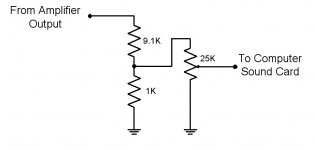The Liberty Audiosuite probes had a series resistor of 47k Ohms in the hot lead, mounted at the probe end of the cable. This went straight into the soundcard, and was good for up to 30v. For higher voltages, the resistor would be increased. This was for the Turtle Beach Fiji soundcard, though I suspect it would suit others. The series resistor would limit input current, and forms a potential divider with the soundcard's input impedence. I would start with a 47k series resistor and see how it goes. It might be a good idea to monitor the soundcard's input voltage at first to see how much the input is attenuated by the series resistor.
I built a little buffer using a BUF03. The input is shunted by a 1M resistor and a 20pF cap. That way, I can use a 10:1 scope probe to attenuate high level signals. If there is offset (e.g., measuring the signal on a tube plate), I capacitively couple to the probe.
The whole shmeer can be built with a couple of 9V batteries into an Altoids box.
The whole shmeer can be built with a couple of 9V batteries into an Altoids box.
I'm afraid that 10:1 isn't enough... I have a E-MU 0404 sound card on the way, and I understand that it is rated for a 'nominal' input of -10dbV (300mV), and a max input of 6dbV (about 2V). So a 10:1 would only allow a max input equivalent to the full output of a 50W amp.
I thought a 10:1 divider in conjunction with the pot would allow me to get the flexibility I'd need. Is my reasoning flawed? (more than usual, that is... )
)
I thought a 10:1 divider in conjunction with the pot would allow me to get the flexibility I'd need. Is my reasoning flawed? (more than usual, that is...
- Status
- This old topic is closed. If you want to reopen this topic, contact a moderator using the "Report Post" button.

